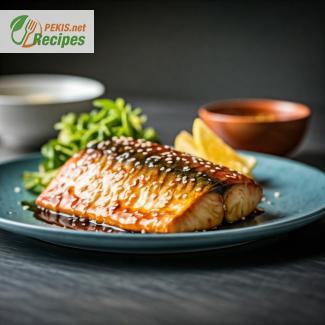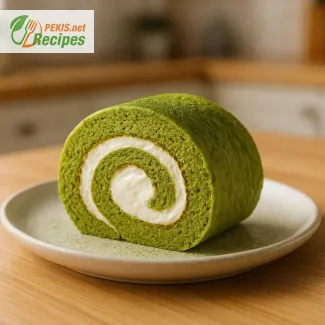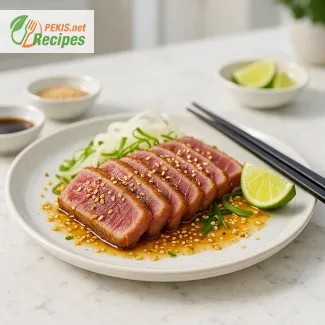
Experience the authentic flavors of Japanese cuisine with this exquisite recipe for Teriyaki Amberjack (Buri no Teriyaki). This dish is a harmonious blend of rich, umami-filled teriyaki sauce and the tender, buttery texture of amberjack fish. Originating from Japan’s culinary heritage, this dish is a true reflection of simplicity, balance, and flavor. Whether you are an enthusiast of Japanese food or simply looking to try something new, this recipe offers a perfect opportunity to bring the taste of Japan into your kitchen.
A Highlight of Japanese Culinary Tradition
Amberjack, known as buri in Japanese, holds a significant place in the nation’s culinary traditions. This high-quality fish is prized for its firm flesh and naturally rich flavor, making it the perfect choice for a dish like teriyaki. The word "teriyaki" comes from "teri," meaning a glossy shine, and "yaki," which refers to grilling or broiling. Together, they describe a method of cooking where a sweet and savory sauce creates a beautiful glaze on the fish.
This dish is more than just food—it is an art form. From the careful selection of ingredients to the precision in preparation, Buri no Teriyaki embodies the philosophy of Japanese cooking: highlighting the natural flavors of the ingredients with minimal intervention.
The Magic of Teriyaki Sauce
The teriyaki sauce is a cornerstone of this dish, delivering a balance of sweetness, saltiness, and umami. Made from a blend of soy sauce, mirin, sake, and a touch of sugar, the sauce coats the amberjack in a luscious glaze that caramelizes beautifully during cooking. The result is a dish with a depth of flavor that is both satisfying and unforgettable. This sauce is versatile and can be used as a marinade, a glaze, or even a dipping sauce, making it a staple in Japanese cuisine.
Amberjack: A Nutrient-Rich Delight
Amberjack is not only delicious but also packed with nutrients. It is a rich source of omega-3 fatty acids, which are known for their benefits to heart and brain health. Additionally, it contains high-quality protein, essential for muscle repair and growth. With its natural richness and mild flavor, amberjack pairs perfectly with the bold notes of teriyaki sauce, creating a well-rounded dish that satisfies both the palate and the body.
Perfect for Any Occasion
Whether you are preparing a special dinner for guests or simply indulging in a delightful meal for yourself, Buri no Teriyaki is a versatile recipe that suits any occasion. The preparation process is straightforward, yet the result is an elegant dish that looks and tastes like it came from a fine Japanese restaurant. Serve it with a side of steamed rice and a portion of lightly cooked vegetables, such as broccoli, bok choy, or snow peas, to create a complete and balanced meal.
The Appeal of Homemade Japanese Cuisine
One of the greatest joys of this recipe is its simplicity and the satisfaction of making an authentic Japanese dish from scratch. By preparing Buri no Teriyaki at home, you have complete control over the ingredients, ensuring a dish that is free of additives and tailored to your taste preferences. Plus, recreating this classic dish allows you to connect with Japanese culture in a meaningful way, enhancing your appreciation for its rich culinary traditions.
Why You’ll Love This Recipe
- Authentic Flavor: Captures the essence of traditional Japanese cooking.
- Nutritional Benefits: A healthy choice packed with omega-3s and protein.
- Easy Preparation: Straightforward steps suitable for both beginners and experienced cooks.
- Versatile Pairings: Complements rice, vegetables, and even noodles.
A Journey Through Flavor
From the moment you take your first bite of Buri no Teriyaki, you’ll be transported to the heart of Japan. The delicate fish, perfectly glazed with the sweet and savory teriyaki sauce, offers a burst of flavor that lingers on your palate. It’s a dish that brings comfort, elegance, and a sense of cultural exploration all at once.
Dive into the world of Japanese cuisine with this Authentic Teriyaki Amberjack Recipe and discover the joy of creating a traditional masterpiece in your own kitchen. Whether you’re a lover of seafood or simply seeking new culinary experiences, this recipe is a must-try.
- Prepare the amberjack: Pat the fish fillets dry with paper towels. Lightly season with a small pinch of salt (1 g or ¼ tsp) on both sides. Let the fish sit for 10 minutes to remove excess moisture. Pat dry again before cooking.
- Prepare the teriyaki sauce: In a small bowl, mix soy sauce, mirin, sake, and sugar until the sugar is fully dissolved. Set aside.
- Sear the fish: Heat a non-stick skillet over medium heat and add the vegetable oil. Place the amberjack fillets in the pan and cook for 2–3 minutes on each side until golden brown. Remove the fillets and set aside.
- Simmer the sauce: Pour the teriyaki sauce into the same skillet. Bring to a gentle boil, then reduce the heat and let it simmer for 3–4 minutes, stirring occasionally, until slightly thickened.
- Glaze the fish: Return the amberjack fillets to the skillet. Spoon the sauce over the fillets continuously while simmering for 2–3 minutes until the fish is fully cooked and coated in a glossy glaze.
- Serve: Arrange the glazed amberjack fillets on a plate. Drizzle any remaining teriyaki sauce over the fish. Serve immediately with steamed rice and sautéed vegetables for a complete meal.
Enhancing and Modifying the Authentic Teriyaki Amberjack Recipe
The Authentic Teriyaki Amberjack Recipe (Buri no Teriyaki) is a flavorful and well-balanced dish that celebrates the simplicity and elegance of Japanese cuisine. While the original recipe offers a traditional take on this classic, there are numerous ways to modify or enhance the dish to suit individual preferences, dietary restrictions, or to explore new flavor profiles. Below are detailed tips and suggestions for ingredient substitutions, cooking methods, and presentation enhancements that can elevate this dish while maintaining its core essence.
Substitutions for Key Ingredients
Amberjack substitutions
- Amberjack is prized for its buttery texture and mild flavor, but it can be replaced with other fish varieties depending on availability and personal preference.
- Salmon: Offers a slightly richer flavor and higher fat content, which pairs beautifully with teriyaki sauce. The result is a creamier and more decadent dish.
- Mahi-mahi or cod: Provide a firmer texture and a more delicate flavor, allowing the teriyaki sauce to shine without overpowering the fish.
- Tofu: For a vegetarian option, firm tofu can be marinated and pan-fried before glazing with teriyaki sauce. It absorbs the flavors well and offers a satisfying alternative.
Soy sauce substitutions
- Traditional soy sauce forms the base of the teriyaki sauce, but adjustments can be made to cater to specific dietary needs.
- Tamari: A gluten-free soy sauce alternative that retains the same savory depth, perfect for those avoiding gluten.
- Coconut aminos: A soy-free and slightly sweeter option that adds a hint of tropical flavor while reducing sodium content.
Mirin and sake substitutions
- Both mirin and sake contribute sweetness and depth to the teriyaki sauce, but they can be replaced or adjusted based on preference.
- Rice vinegar and sugar: Replace mirin with rice vinegar (1 tsp) and sugar (½ tsp) for a similar sweet and tangy effect.
- Apple juice: Offers natural sweetness and mild acidity, creating a lighter and fruitier teriyaki sauce.
- Non-alcoholic white wine: A good alternative to sake, adding subtle complexity to the sauce without the alcohol content.
Adjusting the Flavor Profile
For a sweeter teriyaki sauce
- Increase the amount of sugar slightly or use honey for a more natural sweetness. Honey also adds a floral note that complements the fish beautifully.
For a saltier, umami-rich flavor
- Incorporate a dash of fish sauce or miso paste into the teriyaki sauce. These ingredients deepen the savory notes and enhance the overall flavor.
For a spicier kick
- Add freshly grated ginger, a pinch of red pepper flakes, or a small drizzle of sriracha to the sauce. This introduces a subtle heat that contrasts the sweetness of the glaze.
For added tanginess
- Include a squeeze of fresh lime juice or a splash of yuzu juice after cooking to brighten the dish and add a citrusy zing.
Cooking Technique Variations
Grilling instead of pan-searing
- For a smoky, charred flavor, grill the amberjack fillets over medium heat instead of pan-searing. The grill marks add a rustic touch and enhance the natural taste of the fish.
Baking for a hands-off approach
- Bake the fillets in the oven at 200°C (400°F) for 12–15 minutes, brushing them with the teriyaki sauce every few minutes. This method ensures even cooking and a sticky glaze.
Sous-vide cooking for precision
- For a perfectly cooked amberjack, use a sous-vide machine to cook the fish at 52°C (125°F) for 30 minutes. Finish by glazing and briefly searing in a hot pan for texture.
Serving Enhancements
Accompaniments for variety
- Instead of traditional steamed rice, try serving the amberjack with:
- Quinoa for a nutty, protein-rich base.
- Cauliflower rice for a low-carb alternative.
- Soba noodles tossed in a light sesame oil dressing for a more intricate meal.
Vegetable pairings
- Enhance the visual appeal and nutritional value of the dish by including a variety of colorful vegetables:
- Roasted carrots and asparagus for sweetness and crunch.
- Pickled cucumbers or radishes for a tangy contrast.
- Wilted spinach sautéed with garlic for a savory, earthy side.
Tips for Presentation
Plating with elegance
- Use a rectangular plate for a modern Japanese aesthetic, aligning the fish fillets in a neat row. Add rice and vegetables in clean sections, and garnish with chopped spring onions and sesame seeds.
Finishing touches
- Drizzle a small amount of teriyaki sauce around the plate for a decorative effect. Place a thin lemon slice or yuzu wedge on the side for a touch of color and added freshness.
Impact of Changes on Flavor and Texture
Each substitution or modification affects the dish in subtle ways:
- Changing the fish alters the texture and base flavor, allowing the teriyaki sauce to adapt and complement a new profile.
- Adjusting the sauce ingredients lets you customize sweetness, saltiness, and acidity, creating a balance that matches your palate.
- Exploring new sides and garnishes adds variety and elevates the dish’s presentation, making it more appealing for guests or special occasions.
Experimenting with these modifications allows for endless creativity while maintaining the core identity of Buri no Teriyaki. Whether you stick to the traditional method or add your own twist, this dish remains a flavorful and versatile choice.
Contains soy (from soy sauce) and alcohol (from mirin and sake). This recipe is gluten-free if you use gluten-free soy sauce.
Substitutions for allergens and gluten:
- Replace soy sauce with tamari for a gluten-free version.
- Substitute mirin with a mix of rice vinegar (2 tsp) and sugar (1 tsp) for an alcohol-free option.
- Use a non-alcoholic white cooking wine or apple juice instead of sake.
- Vitamin B12: 5 mcg – Supports nerve function and red blood cell production.
- Vitamin D: 15 mcg – Promotes bone health and calcium absorption.
- Selenium: 40 mcg – Boosts immune function and protects against oxidative stress.
- Omega-3 fatty acids: 1.5 g – Reduces inflammation and supports heart health.
- Polyphenols from soy sauce: 50 mg – Protects against free radicals and supports cellular health.
- Vitamin E from amberjack: 2 mg – Enhances skin health and acts as an anti-inflammatory.
This recipe combines traditional Japanese flavors with the nutritional richness of amberjack, creating a meal that is both delicious and healthful.





